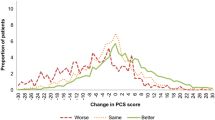Abstract
Objectives: To develop a reliable and valid measure of short-term quality of life after abdominal surgery. Summary background data: A major limitation of clinical trials evaluating laparoscopic surgical procedures has been the lack of a measure of short-term quality of life after abdominal surgery. Methods: We used existing health status measures, focus groups, and semi-structured patient interviews to generate a prototype questionnaire of 51 items, which was administered to patients within 2 weeks after an abdominal surgical procedure. We used structural equations modeling to reduce the number of items, retaining the three items with the highest factor loadings on each of the factors that accounted for one or more eigenvalue. Results: We administered the prototype questionnaire to 500 patients (mean age [SD] 53.4 [16.0], 51.4% male, 73.0% inpatient) at a mean 4.1 days after an abdominal surgical procedure. Item reduction yielded an 18-item measure with 6 sub-scales. The final instrument demonstrated good model fit in relation to our hypothesized factors (root mean square error of approximation 0.085, goodness-of-fit index 0.89). Conclusions: We developed a reliable and valid 18-item, 6-subscale measure of health-related quality of life after abdominal surgery, for use as an outcome measure in studies comparing laparoscopic and conventional abdominal surgery.
Similar content being viewed by others
References
NJ Soper LM Brunt K Kerbl (1994) ArticleTitleMedical Progress: Laparoscopic general surgery N Engl J Med 330 409–419 Occurrence Handle8284008 Occurrence Handle1:STN:280:ByuC3M7nsVM%3D Occurrence Handle10.1056/NEJM199402103300608
JC Weeks H Nelson S Gelber et al. (2002) ArticleTitleShort-term quality-of-life outcomes following laparoscopic-assisted colectomy vs open colectomy for colon cancer: A randomized trial JAMA 287 321–328 Occurrence Handle11790211 Occurrence Handle10.1001/jama.287.3.321
L Neumayer A Giobbie-Hurder O Jonasson et al. (2004) ArticleTitleOpen mesh versus laparoscopic mesh repair of inguinal hernia N Engl J Med 350 1819–1827 Occurrence Handle15107485 Occurrence Handle1:CAS:528:DC%2BD2cXjsVOhtLc%3D Occurrence Handle10.1056/NEJMoa040093
DM Squirrell AW Majeed G Troy et al. (1998) ArticleTitleA randomized, prospective, blinded comparison of postoperative pain, metabolic response, and perceived health after laparoscopic and small incision cholecystectomy Surgery 123 485–495 Occurrence Handle9591000 Occurrence Handle1:STN:280:DyaK1c3ltlahtw%3D%3D Occurrence Handle10.1067/msy.1998.87552
DR Urbach JL Harnish G Long (2005) ArticleTitleShort-term health-related quality of life after abdominal surgery: A conceptual framework Surg Innov 12 243–247 Occurrence Handle16224646 Occurrence Handle10.1177/155335060501200310
DL Streiner (1994) ArticleTitleFiguring out factors: The use and misuse of factor analysis Can J Psychiatry 39 135–140 Occurrence Handle8033017 Occurrence Handle1:STN:280:ByuA3cnivFA%3D
WI Borjesson GA Aarons ME Dunn (2003) ArticleTitleDevelopment and confirmatory factor analysis of the abuse within intimate relationships scale J Interpers Violence 18 295–309 Occurrence Handle10.1177/0886260502250089
JS Long (1983) Confirmatory Factor Analysis Sage Publications Newbury Park
BD Wright JM Lineacre (1994) ArticleTitleReasonable mean-square fit values Rasch Measure Trans 8 370
DL Streiner GR Norman (1995) Health Measurement Scales: A practical guide to their development and use Oxford University Press Oxford
DR Urbach (2002) ArticleTitleLaparoscopic-assisted surgery for colon cancer JAMA 287 1938–1939 Occurrence Handle11960530 Occurrence Handle10.1001/jama.287.15.1938
CL Ireson RW Schwartz (2001) ArticleTitleMeasuring outcomes in surgical patients Am J Surg 181 76–80 Occurrence Handle11248181 Occurrence Handle1:STN:280:DC%2BD3Mvit1SmtQ%3D%3D Occurrence Handle10.1016/S0002-9610(00)00524-9
GL Beets CD Dirksen PM Go et al. (1999) ArticleTitleOpen or laparoscopic preperitoneal mesh repair for recurrent inguinal hernia? A randomized controlled trial Surg Endosc 13 323–327 Occurrence Handle10094739 Occurrence Handle1:STN:280:DyaK1M7psVyluw%3D%3D Occurrence Handle10.1007/s004649900981
B Johansson B Hallerback H Glise et al. (1999) ArticleTitleLaparoscopic mesh versus open preperitoneal mesh versus conventional technique for inguinal hernia repair: a randomized multicenter trial (SCUR Hernia Repair Study) Ann Surg 230 225–231 Occurrence Handle10450737 Occurrence Handle1:STN:280:DyaK1Mznsl2ntA%3D%3D Occurrence Handle10.1097/00000658-199908000-00013
P Juul K Christensen (1999) ArticleTitleRandomized clinical trial of laparoscopic versus open inguinal hernia repair Br J Surg 86 316–319 Occurrence Handle10201770 Occurrence Handle1:STN:280:DyaK1M3hsF2msQ%3D%3D Occurrence Handle10.1046/j.1365-2168.1999.01053.x
N Khoury (1998) ArticleTitleA randomized prospective controlled trial of laparoscopic extraperitoneal hernia repair and mesh-plug hernioplasty: a study of 315 cases J Laparoendosc Adv Surg Tech 8 367–372 Occurrence Handle1:STN:280:DyaK1M7htlKhtQ%3D%3D Occurrence Handle10.1089/lap.1998.8.367
AM Paganini E Lezoche F Carle et al. (1998) ArticleTitleA randomized, controlled, clinical study of laparoscopic vs open tension-free inguinal hernia repair Surg Endosc 12 979–986 Occurrence Handle9632874 Occurrence Handle1:STN:280:DyaK1c3pvVehsQ%3D%3D Occurrence Handle10.1007/s004649900760
M Picchio A Lombardi A Zolovkins et al. (1999) ArticleTitleTension-free laparoscopic and open hernia repair: randomized controlled trial of early results World J Surg 23 1004–1007 Occurrence Handle10512939 Occurrence Handle1:STN:280:DyaK1MvksVWksQ%3D%3D Occurrence Handle10.1007/s002689900615
C Tanphiphat T Tanprayoon C Sangsubhan et al. (1998) ArticleTitleLaparoscopic vs open inguinal hernia repair. A randomized, controlled trial Surg Endosc 12 846–851 Occurrence Handle9602004 Occurrence Handle1:STN:280:DyaK1c3mslehtg%3D%3D Occurrence Handle10.1007/s004649900727
KR Jones RE Burney M Peterson et al. (2001) ArticleTitleReturn to work after inguinal hernia repair Surgery 129 128–135 Occurrence Handle11174702 Occurrence Handle1:STN:280:DC%2BD3M7ltVOjug%3D%3D
K Lawrence H Doll D McWhinnie (1996) ArticleTitleRelationship between health status and postoperative return to work J Public Health Med 18 49–53 Occurrence Handle8785075 Occurrence Handle1:STN:280:BymB28%2FotFM%3D
JS Barkun EJ Keyser MJ Wexler et al. (1999) ArticleTitleShort-term outcomes in open vs. laparoscopic herniorrhaphy: Confounding impact of worker’s compensation on convalescence J Gastrointest Surg 3 575–582 Occurrence Handle10554363 Occurrence Handle1:STN:280:DC%2BD3c%2FitF2rtA%3D%3D Occurrence Handle10.1016/S1091-255X(99)80078-X
M McCarthy SuffixJr O Jonasson CH Chang et al. (2005) ArticleTitleAssessment of patient functional status after surgery J Am Coll Surg 201 171–178 Occurrence Handle16038812 Occurrence Handle10.1016/j.jamcollsurg.2005.03.035
MJ McCarthy CH Chang AS Pickard et al. (2005) ArticleTitleVisual analogue scales for assessing surgical pain J Am Coll Surg 201 245–252 Occurrence Handle16038823 Occurrence Handle10.1016/j.jamcollsurg.2005.03.034
DL Streiner (2003) ArticleTitleStarting at the beginning: An introduction to coefficient alpha and internal consistency J Pers Assess 80 99–103 Occurrence Handle12584072 Occurrence Handle10.1207/S15327752JPA8001_18
DL Streiner (2003) ArticleTitleBeing inconsistent about consistency: when coefficient alpha does and doesn’t matter J Pers Assess 80 217–222 Occurrence Handle12763696 Occurrence Handle10.1207/S15327752JPA8003_01
Author information
Authors and Affiliations
Corresponding author
Rights and permissions
About this article
Cite this article
Urbach, D.R., Harnish, J.L., McIlroy, J.H. et al. A measure of quality of life after abdominal surgery. Qual Life Res 15, 1053–1061 (2006). https://doi.org/10.1007/s11136-006-0047-3
Accepted:
Issue Date:
DOI: https://doi.org/10.1007/s11136-006-0047-3




